|
He said the majority of the 18,000 missing Americans are presumed prisoners. |
|
|

VOL. III NO. 19 REG NO. L5015 DELHI, THURSDAY JANUARY 18, 1945
Convoy Reaches Jump Off Point
The convoy, which pulled into Myitkyina late this afternoon, three days after leaving the railhead bazaar of Ledo, Assam, is being held here pending classification of the route to be taken to China's border and the Burma Road.
At a press conference, Lt. Gen. Dan I. Sultan, India-Burma Theater Commander, and Brig. Gen. Lewis A. Pick, Commanding General of the Ledo Road project, revealed that opening of the road is dependent upon the "eradication" of a Jap suicide force which holds a stretch of roadway between Namhkam and Wanting on the Burma Road.
In discussing the Ledo Road, Sultan said, "Insofar as engineering construction is concerned, there is a physical road to China. In other words, the construction of the Ledo Road, insofar as the movement of limited convoys to China is concerned, is possible. The fly in the ointment is that the Jap still holds a section from Namhkam to Wanting. As soon as they are ejected from that area, convoys can begin moving."
Although he would not venture an estimate of how long it would take to clear that last barrier between a land linkup with China, Sultan declared that the First Chinese Army "has now captured Namhkam," and that the Chinese Expeditionary Force is "fighting for Wanting."
However, should the Tengchung track (emergency road), which Chinese Engineers have been cutting across the backbone of the Himalayas (southeast of Myitkyina) be completed before the Namhkam-Wanting sector of the Ledo Road is cleared for traffic, the convoy will proceed into China over that route, it was also disclosed.
If the Tengchung cutoff is used, the makeup of the convoy, which now includes jeeps, weapons carriers, ambulances, cargo trucks and artillery - all ticketed for delivery to the Chinese in Kunming - probably will be limited to vehicles which can negotiate the steep grades and sharp curves of the road.
It was emphasized that although the convoy will take the first route which is open into China, the Bhamo-Namhkam-Wanting linkup with the Burma Road will ultimately comprise the permanent supply artery for the shipment of heavy equipment to China.
So far, there has been a singular air of destiny about the convoy. It has a contagious spirit which causes G.I.'s working along the Road to stop and watch with quiet eyes as the trucks file past. If the men along the Road sense the culmination of the job well done, and even if they are not riding along, they are proud of the part they played in making the convoy possible. The Negro G.I.'s who had such a large part in the building of the road, will have representatives in the trip to China, Sultan said.
Engineers, truck drivers, wire stringers, G.I.'s who have been tied to desk jobs in the rear echelon - all have played a part in finishing the job which once was branded "Impossible." The early days of the Ledo Road were gloomy. Equipment and personnel were painfully inadequate. native laborers were imported in large numbers, but they were unsatisfactory. Most of the men were untrained and the term of their contract ran for only three to six months, at the end of which time they had to be replaced by new, inexperienced men.
Then came the first monsoon. men at this point underwent untold hardships. They were wet all the time. They slept in waterlogged tents, bamboo lean-to's and moldy jungle hammocks. The soggy jungles were infested with long, purplish leeches, the bites of which festered. 'Dozers were lost over steep banks when the rain saturated the trace, causing the shelves to collapse. 'Dozers were buried in slides and stalled in seemingly bottomless mud.
When Pick assumed command of the Road, it seemed hopelessly stalled in a maze of densely-jungled, precipitous mountains. Eighty percent of the Engineers at the point were hospitalized with malaria. Crews were working but one eight hour shift a day.
Pick called a staff meeting his first night in Ledo. "I've heard the same story all the way from the States," he told his staff, "It's always the same. The Ledo Road can't be built. Too much rain, too much mud, too much malaria. From now on we are forgetting this defeatist spirit. The Ledo Road is going to be built. Mud, rain and malaria be damned."
|
"It is now generally called the Ledo-Burma Road. But there is little doubt that far more appropriately it could be named after the man whose almost single-handed pertinacity is responsible for this spectacular achievement. If history, in an off guard moment, should decide to do justice to one individual this overland lifeline to China should be known as "Stilwell Road." |
And the Road was built. During the past 15 months, it has been pushed from Pangsau Pass at the Burma border to the China border, and a juncture with the Burma Road.
The price of the Ledo Road has not been cheap. Great amounts of equipment and manpower have gone into its construction. From a purely profit and loss point of view, the Road will never be a paying proposition. But wars aren't fought and won on a dollar return basis.
The Ledo Road has justified itself in the part it played in shattering the Jap hold on North Burma and since its inception the Road has been closely related to the tactical strategy of this Theater. gen. Joseph W. Stilwell wanted a road built across the Pataki's and into Burma's Hukawng Valley by Jan. 1, 1944. The Road was through four days ahead of schedule and a convoy of 55 trucks, carrying Chinese troops and equipment, followed the lead bulldozer down
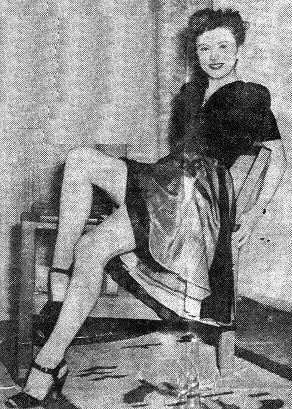 Kansas City is famous for steaks - and also, in our opinion, Betty Lynn,
attractive read-headed songstress, who
specializes in popular ballads and the "blues." Betty is one-half the USO Camp Show 423 (Smoke Rings) now touring
our neck of the war. The other half is Tommy Decker, guitarist-vocalist. The duo also has a collection of ancient
pipes.
Kansas City is famous for steaks - and also, in our opinion, Betty Lynn,
attractive read-headed songstress, who
specializes in popular ballads and the "blues." Betty is one-half the USO Camp Show 423 (Smoke Rings) now touring
our neck of the war. The other half is Tommy Decker, guitarist-vocalist. The duo also has a collection of ancient
pipes.
|
In the Hukawng and Mogaung Valley campaigns, combat roads were cut by Engineers operating armor-plated equipment. Troops and supplies moved on south into Burma through the jungle to the battlefields at Ningam Sakan, Taipha Ga, Maingkwan, Walawbum, Tingwaukm Sakan, Jambu Bum Pass, Shadazup and Warazup.
Aside from the part the Road has played in Allied successes on the battlefields of Burma, it has provided a route for heavy equipment and armament into Burma and China, which could never have been shipped by cargo plane.
Over-emphasis of the importance of tonnage figures has served to create the erroneous impression that the remarkable figure being set over The Hump by air freightage nullifies the value of, and need for the Road.
Conversely, the Ledo Road, now that it has joined with the Burma Road, will serve as a compliment to The Hump freight run. For, while the emphasis in air shipments is on equipment and supplies which are not too bulky, traffic over the Ledo Road into China for perhaps the next year will be concentrated on the delivery of all type of vehicles, equipment and armament to the Chinese armies.
The peak of convoy traffic over the old Burma Road from Rangoon reached an estimated tonnage figure of 19,000 tons a month, much of which was contraband. How the tonnage figures of the Ledo Road shipments into China will compare with that figure is problematical.
Although Sultan declared that this "token convoy" to the Chinese will be followed by many more, he pointed out that future trucking operations are dependent as to their scope on the War Department allotment of stock and personnel to maintain the vehicles.
But all of that belongs to tomorrow's headaches. Today is not the time for worry. American industry and determination built the Ledo Road. American industry and determination will get the freight over the Road. And the G.I. drivers who are sleeping in jungle hammocks by their trucks tonight are the trailblazers of the new Ledo Lifeline to China.
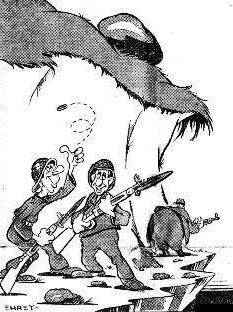
|
CHINA - Adm. Chester W. Nimitz's U.S. Pacific Fleet boldly invaded the China Sea this week in the deepest wartime penetration of Japanese waters.
Carrier-borne planes from Adm. William Halsey's Third Fleet raided the Chinese ports of Amoy and Swatow; Hong Kong; Formosa and Indo-China.
Amoy, Swatow and Hong Kong were hit Saturday, a Nimitz communiqu said. Formosa was raided twice by Navy planes and once by B-29's from China. The first Formosa naval raid cost the Japs 137 ships and 98 planes sunk or damaged.
Tokyo radio said the second raid was by 200 planes on Monday and lasted four and one half hours.
The carrier planes raided Indo-China from Saigon to Camranh bay. Large fires were set around Saigon in defiance of land based aircraft. Four convoys, presumably assembling to reinforce Luzon, were shattered, with 12 troop-filled transports among more than 38 ships sunk or damaged.
Meanwhile in China a Chinese military spokesman said Japan had landed fresh troops in northern Fukien Province. The enemy headed inland but then was forced back to Sansha on the coast, the Chinese claimed.
The Associated Press said the Japanese apparently want to be in a position to rush troops to any point where the Americans might secure a beachhead. A Chinese spokesman said the enemy is taking precautions against American landings at Shanghai, as well as at other points along the coast.
The lull continued in northern Kwansi Province, with Jap concentrations reported at Hengyang. No news came from the Salween Front where at last reports the Japanese garrison was still holding out at Wanting, border town on the Burma Road.
SULTAN'S FORCES TAKE NAMHKAM
BURMA - As the first Ledo Road truck convoy reached Myitkyina, 30th Division, First Chinese Army troops under Lt. Gen. Dan I. Sultan, crossed the Shweli River from the southwest and south and captured Namhkam on the Bhamo spur to the Burma Road.
Meanwhile, First Army patrols moved northeast from the Loi Wing area (where the old AVG airfield was taken at week's start) and contacted units from the Chinese Expeditionary Force. This was the first joining of Burma and China forces near the main supply road to China.
Chinese troops which for several days had been fighting at Mwanhawm, eight miles from Tonkwa, captured the village after heavy fighting.
Namhkam stands at Mile 71 southeast of Bhamo and is 28 road miles from Mong Yu, junction of the Bhamo spur and the Burma Road.
British Units Strike Towards Mandalay
BURMA - Following a shattering air bombardment of Mandalay by Eastern Air Command planes, British 14th Army troops were advancing on the town from Shwebo, reportedly being less than 30 miles away.
Meanwhile, in the Arakan, the Jap defenders were fighting stubbornly, according to a SEAC communiqu . Units of the 15th Indian Corps, which landed on the Myebon Peninsula early in the week in an amphibious operation found the Nips had dug in farther inland. The Japs were also fighting strongly on the Kaladan front.
B-29's of the XX Bomber Command went to work on Singapore again during the week. Four enemy fighters were downed, while no Super-Forts were lost to enemy action.
CHINESE NUPTIALS SET TO JIVE MUSIC
|
MADISON, WIS. - (UP) - When S/Sgt. John W. Parker, leader of a G.I. jive band somewhere in China, was asked to play at a Chinese wedding he was non-plussed, according to a letter received here by his parents.
However, with his commanding officer's approval, Parker and the crew set out in a jeep for a remote Chinese town. He set up the bandstand in one corner of a hall overflowing with wedding guests.
He then proceeded to render a hot version of Don't Get Around Much Anymore, while the guests wildly applauded. The bride came down the aisle to the tune of Pistol Packin' Mama.
MOTHER SEES TRAGEDY
MORGANTOWN, W. VA. - (UP) - Mrs. L. V. Keck, Jr., waiting to greet her flier son, veteran of 50 missions in CBI, saw him die in an airplane crash as he returned home to visit his ailing father in a veteran's hospital.
Capt. L. V. (Jack) Keck III called his mother from Greensville, S.C., to tell her he was coming home in a bomber.
She was waiting at the airport when a B-25 circled the field three times, over-ran the landing strip and crashed into a roadside ravine, killing Keck and three others.
Keck served 15 months overseas before returning to the United States last November as an instructor.
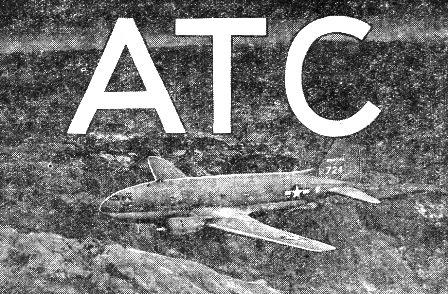 A C-46 Curtiss Commando of the Air Transport Command spans a section of the fabulous Hump run from India to China.
First sent to India before it had been adequately flight-tested because of the urgency of putting into operation a
capacious high-altitude transport, the airplane gave many a pilot the horrors in the early days. But today, its
"bugs" removed, it performs beautifully in its tough assignment of transporting supplies to China.
A C-46 Curtiss Commando of the Air Transport Command spans a section of the fabulous Hump run from India to China.
First sent to India before it had been adequately flight-tested because of the urgency of putting into operation a
capacious high-altitude transport, the airplane gave many a pilot the horrors in the early days. But today, its
"bugs" removed, it performs beautifully in its tough assignment of transporting supplies to China.
|
In its recent operations, the India-China Division of ATC has virtually tripled the tonnage total of some 12,000 tons for which, early in 1944, it was awarded a Presidential Citation.
Termed an "incredible feat of transport" by Prime Minister Churchill, this operation dwarfs any aerial transport venture ever conceived. It now has more pilots and more planes assigned than all the airlines of the United States possessed before the war.
First flight over The Hump came April 8, 1942, by Brig. Gen. William D. Old (then a lieutenant colonel) with a cargo of high-octane gasoline intended for Doolittle's bombers, some of which were to land in China after their now-historic smash at Tokyo. Soon came the tasks of supplying Stilwell's forces in Burma and of evacuating Myitkyina when that since-recaptured base was threatened by the Japs.
In its earliest days, the operation was commanded by Brig. Gen. (then Col.) Caleb V. Haynes. It had a few battered old C-47's, which were joined by others flown by Pan-American pilots who flew as civilians. It was a pitiful trickle of supplies those first few months, for only a handful of the aircraft promised for the job showed up, the rest being grabbed off in Africa to aid the job of beating Rommel. Only one useable airport then existed in Assam, and personnel was limited - so limited that some of Doolittle's pilots who finally returned over The Hump were shanghaied into flying the route for a while.
There were no warning nets to tell of approaching Jap raiders and the only protection the organization had was a pair of P-40's borrowed from Maj. Gen. C. L. Chennault and a pair of P-43's borrowed from the Chinese Government. The transport pilots, mostly combat-trained, alternated with Haynes and Old in flying the pursuits.
The original operation, known as the Assam-Burma-China Ferry Command, gave way on Aug. 1, 1942 to the India-China Ferry Command, under Maj. Gen. Clayton L. Bissell of the 10th Air Force. By late fall, some 600 tons a month were crossing The Hump for the use of the Chinese and Chennault's growing air force. But from Washington and Chungking the cry was for more.
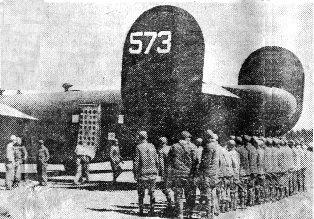 The ICD's China Wing, besides receiving cargo transported over The Hump and expediting turn-about of aircraft
to their India bases, also operates extensive transport activities in support of tactical forces. Here a group of
Chinese soldiers board a C-87.
The ICD's China Wing, besides receiving cargo transported over The Hump and expediting turn-about of aircraft
to their India bases, also operates extensive transport activities in support of tactical forces. Here a group of
Chinese soldiers board a C-87.
|
The India-China Wing of the newly organized Air Transport Command was activated on Oct. 29, 1942, and took over all India-China operations under the direction of Col. (now Brig. Gen.) Edward H. Alexander. Alexander was in command during the pioneering period, when techniques were developed and routes charted. His headquarters was on a tea plantation, with one of the bungalows serving as quarters for him and his staff, midway between three airports from which operations over The Hump were conducted. The connections of his headquarters with the outside world depended upon highway transport, which at times was impossible during the monsoon season, two telephone lines to the nearby fields, and a landing strip for small airplanes, from which it was necessary to drive the cattle before take-offs and landings.
Early in 1943, in view of the urgent need of a capacious and fast-climbing airplane in The Hump operation, the first Curtiss C-46 transports were rushed out from the States and put into use. Hauling far more than its predecessors, it nevertheless caused its own troubles, for it was relatively new and untried. Modifications had to be made on the spot, with practically no facilities and no spare parts, the mechanics lying on their backs in the monsoon mud or perched on improvised crew chief stands under a broiling sun. Eventually, the difficulties were ironed out and the craft proved efficient and valuable. About this time, the C-87 Liberator Express, a four engine plane converted from bombing purposes (B-24), was tried out and proved another satisfactory addition to The Hump fleet.
Alexander returned to the United States in October, 1943, and was succeeded by Brig. Gen. Earl S. Hoag. Tonnage mounted abruptly when it was decided to fly The Hump 24 hours a day, instead of during daylight only, and in December came the record tonnage which earned the Unit Citation by President Roosevelt for "exceptionally outstanding performance."
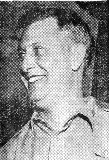 Brig. Gen. William H. Tunner commands the India-China Division, ATC. He arrived in India in September, 1944, from
the ATC's Ferrying Division, which he had headed since its establishment in 1942.
Brig. Gen. William H. Tunner commands the India-China Division, ATC. He arrived in India in September, 1944, from
the ATC's Ferrying Division, which he had headed since its establishment in 1942.
|
On March 21, 1944 Hoag was replaced as Wing Commander by Brig. Gen. Thomas O. Hardin, who had formerly been in command of the sector of the wing which flew The Hump. Under his command, tonnage figures continued to mount, and personnel and aircraft in the Wing were augmented. On Aug. 1, the India-China Wing became a division, and on Sept. 3 was placed under the command of William H. Tunner, former commander of ATC's Ferrying Division. It is now the largest of ATC's nine foreign divisions and The Hump operation is ATC's largest single overseas project.
Just before leaving the United States, Tunner had been awarded the Distinguished Service Medal in recognition of development of the Ferrying Division. he already had been entitled to wear the Air Medal for pioneering ATC's ferrying route across the Azores.
Shortly after he assumed command, the India-China Division was split into two wings, one handling Hump traffic and the other maintaining the vast airline system throughout India which is necessary. More recently, a third and fourth wing have been added - the Bengal Wing, which delivers long-range cargo to China, and the China Wing, charged with receiving Hump cargo and expediting "turnabout" of Hump aircraft, and also with operating extensive transport activities within China in support of tactical forces.
The division has been called upon many times to move troops by the thousands. On one occasion, 15,000 Chinese troops were flown over The Hump to India for training, without a single casualty, and later flown back to help in the battle for Myitkyina. The ICD has also lent its help in the evacuation of air bases threatened by the enemy, saving tons of critical material from falling into Jap hands. On occasion, its planes have aided those of the Troop Carrier Command in dropping supplies to beleaguered ground troops - British, Chinese and American. It played its part, too, in helping to haul Wingate's raiders into Burma.
Cargo of every conceivable type has been flown - road-building machines weighing up to 6,000 pounds, gasoline, bombs, ammunition, aircraft engines, blood plasma and whole blood, trucks and jeeps. One of the oddest loads was made up entirely of canoe paddles, later used to propel the river craft which crossed the Salween when the Chinese started their offensive on that front.
In addition to flying its various routes, the India-China Division maintains a complete transient service, including restaurants, laundries, taxi accommodations, dispensaries, and all else needed to assure reasonable comfort to travelers along its far-flung air lanes. In a single month it has served 227,994 meals to transients and provided 75,184 billets.
COMMERCIAL RADIO BETWEEN U.S.-CHINA
WASHINGTON - (UP) - The federal Communications Commission in its annual report to Congress revealed that commercial radio-telephone service between the U.S. and China may be opened early this year after completion of the installation of new, efficient equipment at an undisclosed terminal in China, presumably Chungking.
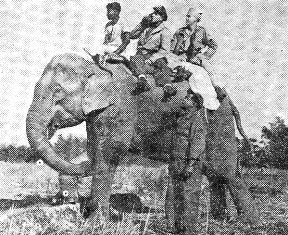 Out in the open country, the plane relays messages to guide an elephant salvage party to a fallen aircraft by
"walkie-talkie" from the ground station. It was all strictly new to the Indian guide. Behind him aboard the
pachyderm
are Lt. Robert C. Waldron and S/Sgt. John Q. Adams, while M/Sgt. James W. Foch is the lad afoot.
Out in the open country, the plane relays messages to guide an elephant salvage party to a fallen aircraft by
"walkie-talkie" from the ground station. It was all strictly new to the Indian guide. Behind him aboard the
pachyderm
are Lt. Robert C. Waldron and S/Sgt. John Q. Adams, while M/Sgt. James W. Foch is the lad afoot.
|
ELEPHANTS WIRED FOR SOUND
ASC BASE, ASSAM - Newest, although unheralded ally of the Army Air Forces serving in the jungle fastness here is "Jumbo" and his kin. Back home, "Jumbo" is the big fella in the zoo, fed peanuts by the youngsters or applauded at the circus. Here, however, "Jumbo" leads a more industrious and varied life, moving bulk tonnage where there are no suitable roads and using his sheer strength for lifting purposes where manpower is short.
The Air Service Command men under Maj. Gen. T. J. Hanley, Jr., have found new practical uses for "Jumbo" and his family since the AAF settled in this uninitiated Theater of Operations. Their most vital contribution as an ally of the G.I.'s has been in the salvage of crash-landed aircraft.
"Wiring Elephants for Sound" is the latest chapter in "Jumbo's" war effort here. The Global Planesman, crack ASC group which has served in the African, Sicilian and Italian invasions in addition to Burma, received a call about a fallen cargo plane in the jungle, 30 miles from their base. The map indicated to Maj. Louis R. Hampton, Engineering Officer, that the plane was down in a wild-game reservation. A scout plane located it in the heart of jungle density. This was "Jumbo's" forte. There were no roads and the wild game was not to be accepted as a triviality.
After the Global Planesmen had surveyed the situation and mapped their plans, three elephants were included as part of their equipment. The scout plane, piloted by Lt. John R. Bridgeman, was to relay by radio to a temporary ground station in a tea planter's cottage the direction for the salvage party, carrying its essential equipment atop the elephants, to proceed. From the radio station in the cottage, the contact with the pachyderm caravan was to be made by "walkie-talkie." Over each elephant a canopy of a white sheet was drawn to make the convoy easily visible from the air. The frequency of the scout plane's radio was adjusted to conform to the ground sets and tested.
It seemed at first like a fabulous idea, something dreamed up for a Hollywood scenario, but it turned out to be as solid as granite. Lt. Robert C. Waldron, M/Sgt. James W. Foch, S/Sgt. John Q. Adams and Pfc. Joe P. Bonon, got their Indian guides and elephants and "walkie-talkie" equipment and proceeded along their sketched plans to the crashed plane, completed their mission, and then wished they had some peanuts to feed their Jumbos.
There was good reason, too, why the Jumbos should have peanuts. The party cleared the base early one dawn and had barely entered the wild game reservation when the air suddenly seemed seethed with misfortune and danger. The leading Jumbo was suddenly attacked by a rhinoceros which appeared from the undergrowth and thrust itself in hockey body-check fashion at the elephant. Jumbo, however, turned wildly in circles and roared, swinging a massive trunk in all directions while G.I.'s aboard held on to the best of their ability. The rhino retreated and disappeared and the calm that ensued was the most welcome ever.
Thereafter, the scout plane dipped lower along the trek and warned of other wild game stalking about as the party proceeded.
Jumbo will not be sitting at the peace conference, but he's a solid ally here in India's jungle and whenever peanuts arrive he's bound to be in on the ration.
'Earthquakers' Disclosed As 12th Bomb Group
To the Roundup's clientele, they've been "The Earthquakers."
Now they may be called by their official designation, the USAAF 12th Medium Bombardment Group, according to Eastern Air Command Headquarters.
They arrived among us early in 1944, but don't get the idea that they were Johnny-come-latelys overseas. Before joining Maj. Gen. George E. Stratemeyer's EAC, they had already carved themselves a solid niche in aerial history.
One of the first medium bombardment groups to be sent over the water, the 12th joined the Desert Air Force in 1942 to help Field Marshal Sir Bernard Montgomery's 8th Army drive Rommel from North Africa. It participated in the Battle of El Alamein, conceded to be the turning point of the war.
BLITZED MARETH LINE
In the Spring of 1943, "The Earthquakers" (so named by the harried Germans) blitzed the Mareth Line so that the 51st Highland Division could pierce it; they bombed troop concentrations and gun emplacements for the gallant Fourth Indian Division; and they hammered unmercifully at the Luftwaffe's bases in Tunisia.
When the Desert Fox was trapped near Enfidaville, the 12th pummeled the corridor that contained the remnants of his troops, dropping over 485,000 pounds of bombs there.
With Sicily in Allied hands, the group took part in softening-up the Italian coast for the landings at Reggio and Salerno and as the 8th Army surged up the Italian mainland, the hard-hitting B-25's followed.
In January, 1945, the group made its last move forward in Italy, to an airfield near Salerno. There it received orders to move to India.
IN ACTION SOON
A few months after joining EAC, "The Earthquakers" were busy destroying Jap stores at Mogaung, Kalewa and Kalemyo in Burma and disrupting enemy traffic on the railway from Mandalay to Myitkyina. They bombed the Tiddim Road and railway bridges and helped Troop Carrier cargo planes supply the British 14th Army in Imphal.
When in July, Gen. Joseph W. Stilwell ordered Myitkyina taken, the ubiquitous group was called in and, during a 12-day period one of their squadrons carried out 360 sorties.
During the monsoon months following the steamy spring, the 12th kept flying. When the advance of the 14th Army was held up by the Japs dug in on Kennedy's Peak, "The Earthquakers" flew over and bombed them out.
Under command of Col. Lloyd H. Dalton the 12th is still flying in close co-operation with British ground forces. Most recently they have been clearing the way for the 15th Indian Corps drive on Akyab. Scheduled to bomb Akyab on D-Day, they discovered there was nothing left for them to bomb.
Oops!
G.I. FORGETS CRUTCHES
ALONG THE LEDO ROAD - The room at the general hospital's Red Cross Club was packed to its pukka sides. It was Bingo night. Crutches and casts dangled across tables and chairs, as convalescing patients placed little squares on the shouted numbers.
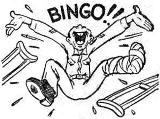
|
Some G.I.'s not content with a card or two, placed several in front of them, determined to win prizes of cigarettes and chewing gum. One conservative jungle wallah decided to play it close to the vest. He selected one card, squared himself comfortably and listened for the Bingo barker to pull out the tell-tale digits.
First, luck played to the law of averages. The boys with many boards tripped up to the stand - came back with juicy takes. Finally, the little fellow hit. He shouted, "BINGO!" jumped up and started on the double to collect his winnings.
Half-way up the room, his buddy turned, gulped and shouted after the retreating figure, "Hey, Sam, you forgot your crutches." Sam stopped short, discovered his error of omission and with agonizing facial contortions hobbled back to his chair. Reunited with the crutches, he retraced his steps to collect the prizes.
"Gee, even the lame walk for a Bingo prize in Assam," one discerning convalescent mused.
MARAUDER GETS BARS IN STATES
ASHEVILLE, N.C. - T/Sgt. Alfred M. Greer, formerly of Merrill's Marauders, is now wearing the shiny gold second lieutenant bars he earned in the campaign in the Burma jungles last spring and summer.
It was April 10, 1944, that Greer, leading a platoon of the Marauders, was told that a superior officer had been wounded and that "from now on you're a second lieutenant."
But months passed - months of fighting mud on the march through Burma, fighting Japs for the Myitkyina airstrip, fighting dread typhus fever in an Indian hospital, before the rarely-given field commission caught up with Greer.
By then Greer had been shipped home and assigned to the Army Ground and Service Forces Redistribution Station here. He is one of seven men of 3,000 Marauders to have been honored with a field commission.
ANYTHING CAN HAPPEN IN BURMA
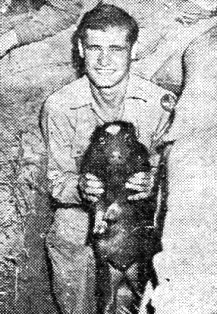
Pig in a Poke? |
TENTH AIR FORCE HQ., BURMA - Just how Pfc. Guy Tedesco, a Special Service assistant of a 10th Air Force, EAC, fighter control squadron, acquired a two-foot long 50-pound wild pig still is a source of amazement to him, but there in a foxhole beside his tent is the incontrovertible fact that he has. The shaggy, black-haired pig is quite real, thank you.
Tedesco hazily remembers that during the late-lamented holidays he was walking to his tent after partaking of copious New Year's spirits with his buddies and "heard somebody following me." He paid no heed, however, until he walked into his tent. Then he found he was sharing it with a pig, who appeared to want to be friends. Not feeling too chipper after all his celebrating, Tedesco kicked the animal outside.
When the pig let out a sorrowful squeal, Tedesco repented to the extent of taking the porker into his arms to comfort her. (It now being established it's a she.)
Then he carried the animal outside in an effort to lose her. But back into the tent she came. Desperate, the G.I. ran through the area for a half hour to ditch the pig, porker, but met with a discouraging lack of success.
Suddenly, Tedesco realized he had "adopted" a pet.
He had no place to keep her, so he finally thought of his foxhole.
Tedesco's pals have decided that the animal would make a fine roast pig dinner, but Tedesco isn't sure. "She is the first female I've ever found I could get along with," he explains.
PX PRICES
TO BE REDUCED
Authorization for the Army Exchange Service to reduce selling prices of the majority of curio items carried by PX's has been made by Brig. Gen. J. A. Warden, Commanding General, SOS.
The revised selling prices will go into effect beginning THIS FRIDAY.
The general declared that the disparity of curio prices in exchanges compared to the civilian market has been realized, but the readjustment of these prices required a study of the inventories and market values before definite action could be taken.
In the future, said Warden, PX's will stock only a limited supply of curio items when they can be procured at reasonable prices.
FEA TO LEND-LEASE SUPPLIES TO CHINA
NEW YORK - According to an interview in the new York Herald-Tribune, Foreign Economic officials have stated that the U.S. will soon Lend-Lease to China spare parts for industrial equipment, raw materials, several thousand heavy trucks, a complete oil refinery plant and a number of power plants to equip China for a greater role in the war against Japan.
It was also stated that as soon as war conditions permit, huge supplies will be sent to China. A complete maintenance unit of "several hundred Americans" soon will be recruited by the Army and the FEA under the "highest possible priority" to keep trucks operating at top efficiency in China.
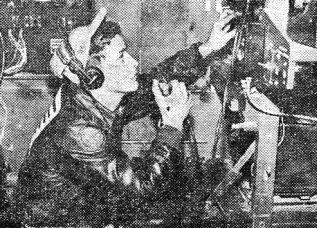
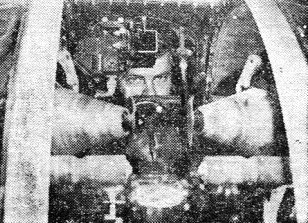 Meet two of the enlisted men who manned the night-searching B-25 in which Roundup's ace correspondent,
S/Sgt. Edgar Laytha participated in a recent Burma raid. Top, Sgt. J. D. Miller, radio operator; bottom,
Sgt. J. C. Lightvoet, engineer-gunner.
Meet two of the enlisted men who manned the night-searching B-25 in which Roundup's ace correspondent,
S/Sgt. Edgar Laytha participated in a recent Burma raid. Top, Sgt. J. D. Miller, radio operator; bottom,
Sgt. J. C. Lightvoet, engineer-gunner.
|

|
The bombers have to fly almost at tree-top level, and, where there are no trees, even lower. They have to dive into narrow valleys, skimming hill tops they cannot see. For a big bomber with the wing span of the B-25, these operations demand nerve-racking alertness and courage from the crew.
I have just returned from such a night mission. The six man crew of our B-25 averaged 22 years old. They were members of the "Skull and Wings," the famous 490th Medium Bombardment Squadron, 10th Air Force. The Burma Bridge Busters, as they are called, tackle railway junctions, tunnels, river shipping, supply dumps, troop concentrations during the day, and, of course, their legendary bridges, one of which the squadron destroys every three days. They helped to paralyze the enemy's supply lines from Bhamo down to Rangoon - until the Jap got wise and restricted his movements to the nights, when flying in Burma is hazardous.
The time was 10:30 p.m. While the men waited for the moon to rise, it was so dark at the airfield that they scarcely could see each other's faces. There was a subdued nervousness about these boys before takeoff.
Not that animated excitement so many fliers feel before an important mission. It was that unexplainable scared courage the Infantryman feels in the jungle when he knows that enemy is all about him but cannot be seen.
The men discussed the briefing. Definite targets for the night were few. Military objectives in the towns of Namhkam and Lashio were their only concrete aims. First priority on their agenda was moving trucks and trains. In case they couldn't knock them out, they were briefed to make them turn off their lights in order to harass the enemy's operations.
At last, very slowly, the moon rose. It was large and yellow. It lit faintly the white skull insignia on the dark grey bomber. But the moon had to climb to mid-sky until its new, lighter glare became their guide. They took off and winged into the night.
The exhaust engines behind the propellers blew their familiar eerie blue flames, meaning the engines were working well. But the ship retained the ugly, often brain-splitting roar of all low-flying Mitchell bombers. Its roar bored itself through the silence like a steel drill through hard rock. Yet, the six men of the crew loved this ship. They knew she was no glamour girl; but therein was her real virtue. She was the terror of the enemy. Liberated Burmese villagers told me just recently how fright-struck one Jap was when this merciless American plane strafed, that he was crippled by a stroke and had to be evacuated to Mandalay.
The jungle was black as a coal heap. At times fires glared up from down below. Campfires of the Mars Task Force and of our Chinese and Kachin allies. The navigator knew their positions. As we left them behind, the fires below were only Japanese. The Japs did not bother about blackout because they knew we did not. We were out for bigger game.
For an hour or so, the trip was eventless. Then, suddenly, mountain ranges blocked the flight and the crew became alert. And now, fellows, it is high time that you met the gentlemen personally.
There was no wise guy among them, no cafe society playboy. They were straight, clean-cut young American who flew a Little America through the Burma air. Lt. W. E. Manche, who once drove a truck in Chicago, was the pilot. At 25 he is a serious, quiet man who knows too well he isn't flying a pleasure ship. The bombardier-navigator, Lt. Raymond C. Kroker, is a 22-year-old ex-college boy from Elwood Park, Ill. The co-pilot, Lt. Ernest L. Evenson, 22, used to farm in South Dakota. The engineer-gunner, Sgt. J. C. Lightvoet, 20, interrupted a course in a Chicago trade school to join the Army. Tail gunner Sgt. A. Popovich, 23, was a brewer in Yonkers, N.Y. Lastly, Sgt. Junior D. Miller from Nevada, Ohio, who was 20 just the night before, used to work in the shipping department of the General Electric Company.
It was bitterly cold in the glass nose. We were flying at 9,000 feet. The moon lent a silvery gleam to the clouds below. Our Little America seemed to touch the stars, but a minute later we virtually dipped from high heaven into blazing hell.
This is what happened. The navigator spotted a convoy of trucks moving through Namhkam, the Japanese stronghold in the Shweli River Valley. We had just time enough to locate them. We dived from 9,000 feet to 100 feet, the lights were out and the trucks immobile. In the split second when we were lowest, the co-pilot released two bombs. While we swooped up again, the bombs accomplished their duty. They exploded on a supply dump which caught fire and lit up the town. During the next dive, the team worked like a well-precisioned machine. As the glass nose hung vertically over the main street, the navigator at my side opened up to strafe with his flexible 50-caliber machine gun. At the same time, the pilot in the cockpit pushed the button handling of the two stationary side guns which aim with the nose. As our fire-spitting ship flanked the target, Junior fired his waist gun, Lightvoet strafed from the turret, Popovich from the tail. The result: two trucks burning.
We dived seven more times. Altogether, it took us three bombing dives and five strafing passes to knock out nine trucks. This satisfied the crew and we turned towards the rest of the Burma Road which was still in Japanese hands.
Trucks were moving down to Lashio and Mandalay, scores of them. But now the Jap was smarter. he turned his lights out in time and as we strafed we lost his positions. But the trucks were scared to move on for a while, their retreat was slowed down. The spectacle below was altogether rather humiliating for the little bowlegged bastards who came to Burma cocky conquerors. The Jap below knew that the 10th Air Force was round the clock all over Burma when the moon is high. Yet, he risks to move even when the night is ours. Such a man must be in a pressing hurry to get out.
We couldn't get in at Lashio. Heavy clouds mantled the town and hid the surrounding hilltops which very easily could have made an end to our journey, whose climax still was far away. We remained at 9,000 feet and crossed over to the Railway Corridor. En route, we saw a town in flames. Whole street blocks burning galore. It was Mogak, the world's ruby center. B-25 daylight raiders set it aflame sometime in the afternoon. Just before we winged into the Corridor, the boys descended on another Japanese communications center, burned up a large building which dragged half a dozen of the surrounding bashas into its abyss of flames.
In the Katha-Mandalay Railway Corridor, the main target of the night, we began to hunt for Japanese supply trains. Skimmed above the tracks like a huge dragonfly skips the waters. We flew as low as a bomber ever can fly. The nerves of the crew were now strained to the utmost, for at spots trees flanked the track lines. An error of a few feet could have wrecked us.
For 20 minutes, we followed the track line. Then we saw a train coming and halt suddenly. The ship swooped skyward, reconnoitered, the dived. Again, Evenson, the co-pilot, released the bombs. Lucky hits. The dry bush below caught fire. The fire spread, at itself into the countryside, made it glow in a dazzling, reddish light. We remained in the sky for a while, waiting for more complete illumination. We got it and counted 20 freight cars and the engine still steaming.
Dive. We aimed at the center of the train to set a car afire for light, should the bush burn out. This took 10 dives. But very soon three cars were burning. Unfortunately, the burning cars were in the center of the train. The black engine at the end still was only faintly visible. And that wretched engine was our chief prize. We couldn't very well risk to run out of ammunition by strafing all the 20 cars into scrap and leave the engine alive to be used for other Jap trains.
While all this happened, the landscape in the distance flared up now and then and we knew our comrades were doing their job elsewhere. And I wondered about those impotent little Japs in the train, how they must have felt being unable to answer fire by fire. And I remembered that silly son of Mussolini who called the strafing of defenseless Abyssinians a sport divine. For our American B-25 crew, the spectacle of tonight was anything but sport. For them, it was a serious pursuit of duty into which they poured all their courage and all their strength.
We made about 14 futile dives at the engine. The plane inside was now hot as hell, specially suffocating in the nose. Gun powder dust and flying sparks made breathing difficult. Judging from the navigator, who sweated bitterly at his gun, the crew must have reached the climax of physical endurance. It invested the same supreme effort into every dive.
The 15th engine dive finished the job. Kroker, the navigator, opened up from the nose, Manche, the pilot, followed up with his stationary guns. Then the pilot followed past the target as if a fighter plane was making a pass at a bomber. Junior, the waist gunner, took immediate advantage of the flanking position, Lightvoet strafed from the turret. And as before, Popovich gave the last kick with his tail gun.
The engine burned. We had ammunition for three more dives. So we hit the poor thing three more times and returned to our base. It was 3;30 a.m.
I was too tired to sleep that night. It was like walking after skiing. The earth seemed unreal for ordinary gait. As the morning dawned, I thought of Junior, who was 20 but scarcely looked more than 17. How will life be to Junior again in the shipping department of General Electric? How will it taste to the farmer in the crew, to the brewer? They have mastered a terrifying bomber, and the air over the treacherous Burma night. After these, they certainly will be strong enough to master the ordinary obstacles of an ordinary man's life. This will be their heritage of Burma. For here in Burma they became men.
LIEUTENANT OUTRANKED BY A DOG
SOS Provost Marshal Lt. Col. Charles Meyers has had his ears beset by a variety of strange and fascinating excuses but he's willing to attest that very few defenses he's heard have topped that offered by a member of his own section this week.
Disheveled, bearded, eyes red-rimmed from lack of sleep, Lt. James A. Moody reported to his boss, hours after he was scheduled to have returned from the Assam valley.
"Sir," apologized Moody, sensing - and correctly so - that the colonel would be interested in his whereabouts "I was outranked by a dog."
The question that the colonel was about to ask strangled and died, stillborn, in his throat.
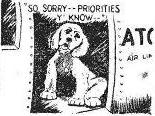
|
He settled back in his chair, obviously awaiting details.
Related Moody:
"Our plane landed at an ATC base near Calcutta and we alighted to wait for the next through ship to Delhi. Shortly after, another ATC plane landed.
"Well, colonel, we had noted a large sign, "PRIORITIES STRICTLY ADHERED TO," so I checked the passenger list of the second ship. According to my mathematics, I'd be safely on that Delhi-bound plane.
"Then we noticed a large box over which a captain on the second plane showed much concern. Inspecting the box more closely, we read the sign, 'Feed the dog soft food because he has an undeveloped lower jaw.'
"The captain rewarded our curiosity. This dog, named 'Ding Ho.' was going back to the United States, he informed us. His master had been killed in a plane crash and his parents had written to the War Department to send them the dog as personal property of a citizen dying in a foreign country. It was strictly kosher, all right, for an official paper accompanying 'Ding Ho' confirmed this. The captain was escorting the dog.
"'Ding Ho's' jaw was underdeveloped, we learned, because a hawk had swooped down and picked him off the ground while he was on a leash. When the slack on the leash was spent, 'Ding Ho' was jerked out of the hawk's clutches.
"When the Delhi plane arrived, I expectantly approached the plane. Well, 'Ding Ho,' accompanied by the captain, boarded the plane, but not your man Moody, although they had the same 4 Priority as I, and had arrived later. Five others who accompanied me from Assam received similar fate.
"Imagine, outranked by a dog. We had to wait 30 hours for the next plane."
The colonel strove mightily to conceal a grin. "Even if it isn't true," he declared, "excuse accepted."
MONKEY BUSINESS
CORRESPONDENT SKIPS A MEAL
By HUGH A. CRUMPLER United Press Correspondent
WITH A KACHIN TRIBE, BURMA - "Come over to the camp this evening," the American officer who was friendly with a tribe of Kachins, said, "and they'll treat us to something different in chow, a real, full-blown Kachin monkey dinner."
Being somewhat of a two-legged guinea pig for anything in the way of food that doesn't come out of a K ration or C ration box, I heartily accepted.
The Kachin head-man, a tough, wiry little fellow who could have been almost any age, went out early in the morning and picked off an even half-dozen fat monkeys with his trusty rifle. He was supervising six of his tribe in the ritual of readying the food for the cooking pot when I arrived on the scene.
That was my first mistake. Before you accept an invitation to a monkey dinner, make it a condition that you don't watch your hosts prepare the feast.
The head-man, presiding over his workers like a high priest preparing an appeasement sacrifice to some angry god, seemed to be satisfied with the way things were going.
Relieving one of the Kachins of a monkey, he whacked off its paws with his long "daw," and returned to the carcass. Spitting the paws on a bamboo stick, he squatted before the fire and began roasting himself a few hors d'oeuvres.
"Sure, they like the paws," the American officer, a soft-spoken southerner, whose identity cannot be revealed for security reasons, told me. "They also consider the brains and eyes great delicacies."
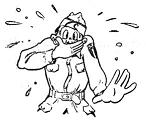
|
Defying all laws of gravity, the contents of my stomach seemed to be headed uphill.
The operations going on around me didn't help. The Kachins had dipped the whole monkeys in boiling water, scraped off the fur and were busy giving the carcasses what looked like to me, the Burmese version of a Swedish massage.
Then they dunked the whole monkeys into a big cooking vessel in a sitting position. The eyes peered out over the pot's rim. I suggested to my American friend that we go sit under a banyan tree somewhere and talk about Tibetan architecture.
The next Kachin I saw, a little man with a Fu Manchu moustache and a devilish gleam in his eye, was holding a plate of steaming rice and red meat under my nose. I took it and with a cheerful, "Well, I'll try anything once" - pronounced in tones usually reserved for such phrases as "Send my ashes to my Mother." - began eating.
Somehow, I accidentally licked over my plate. In fact, I clumsily stepped right in the middle of it.
The host offered to get me another serving, but I politely said, "Oh, no, no, no, I wouldn't think of putting you Kachins to any more bother."
After this little exchange of niceties I queried the other visitors; "What, if anything, does this taste like to you?" I got the following answers:
"Lamb chops."
"Cherrystone clams."
"Breast of guinea hen."
"Monkey."
M/Sgt. Hunt Crawford, who voiced the last observation was, I think, right.
The Kachins wound up their banquet with a "daw dance," during which they show all the symptoms of a nervous breakdown and, with their machete-like knives, decapitate any enemy who might happen to be hissing around in the air overhead.
before I left the camp, it occurred to me that I hadn't seen my friend, the American officer, smacking his lips over any long-tailed fillets. I asked him why.
"I've never touched the stuff," he said, "K rations are good enough for me."
U.S. MEDICO ON SALWEEN FRONT
Y-FORCE HQS., CHINA - Successful progress of the current Salween campaign can certainly be attributed, in some measure, to Capt. Kenneth M. Scott and others like him in the U.S. Army Medical Corps who have done so much towards keeping the Chinese soldier in fighting trim.

|
Twenty-eight-year-old Scott, member of the Medical component of Brig. Gen. Frank Dorn's liaison group with the Y-Force has been caring for ill and wounded Chinese troops since the campaign first began back in May, 1944. During that period, it is estimated that his unit has returned a larger number of soldiers to duty than any other group in China's history of war.
marching alongside the Chinese through the rugged terrain both east and west of the Salween River has provided Scott with many experiences, laughs and not a few hardships.
"As a surgeon with the Chinese Army," Scott relates, "I had more walking to do than ever before in my life, and over tougher country. Going over some of those mountains would make Pike's Peak look like a child's playground. And when it rained, some of the trails were impossible even to stand on.
"After crossing the Salween, we found the trails and the rains just as bad. I frequently saw litter patients climb out and walk up a steep mountain because it was too much for the carriers. And once, when a litter bearer collapsed, the patient swapped places with him, carrying one end of the litter himself!"
Scott, born and raised in North China, but educated in the States, is a graduate of the Medical School at the University of Pennsylvania. After being called to active Army duty in 1942, he was soon sent to India to help train and advise medical officers of the Chinese Army. It was here that he was closely associated with Col. Gordon (Burma Surgeon) Seagrave and his band of Burmese nurses.
"This Seagrave unit is a most amazing group," said Scott, "and I wouldn't trade the clinical experience I gained under them for anything."
Then in September, 1943, the captain was ordered to Y-Force headquarters to open a medical school a "refresher course," for Chinese medical officers. Upon completion of this duty, he was assigned to accompany the Chinese in their offensive across the Salween.
14TH'S RESULTS ASSESSED
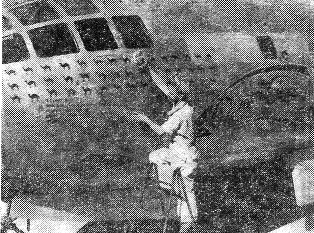 CAMEL CARAVAN, B-29 Super-Fort converted into a "flying tanker" last June to haul gas across The Hump, has been
retired from combat and returned Stateside for use in transitional training. Pvt. Bernard H. Christ gives Camel
Caravan's 47 camels, each representing a round trip over The Hump, a final polish.
CAMEL CARAVAN, B-29 Super-Fort converted into a "flying tanker" last June to haul gas across The Hump, has been
retired from combat and returned Stateside for use in transitional training. Pvt. Bernard H. Christ gives Camel
Caravan's 47 camels, each representing a round trip over The Hump, a final polish.
|
TOTAL OF 1,763 JAP PLANES BAGGED
HQS., 14TH AIR FORCE, CHINA - More than 1,749,000 tons of Japanese shipping and 1,763 planes have been destroyed by the 14th Air Force since July, 1942, Maj. Gen. C. L. Chennault disclosed this week, adding "You can almost count the ships and planes left to Japan."
The commanding general's official summary of damage ... during this period also included 442 locomotives destroyed, plus 265 railroad cars, 3,115 trucks and 60 armored vehicles. It was also announced that since June, 1944, 30,000 enemy troops have been killed by 14th Air Force aircraft. Only 121 14th aircraft were lost.
Estimating that one-third of the Jap air force in China was destroyed in December. Chennault said 241 Nip planes were downed in addition to 73,150 tons of enemy shipping sunk.
For the past week, "non-operational weather" prevented the 14th from carrying out its devastating raids in large numbers. P-51's, however, did sneak in several attacks against enemy shipping and docks along the Yangtze River, sinking several small vessels. At Wachow and Hankow, 24 enemy planes were destroyed. Other fighters and bombers concentrated on Nip troops and installations in the Wanting-Muse area in support of Chinese ground forces. Five U.S. planes were reported lost.
DAVIDSON CITES 490TH BOMB
HQ., 10TH AIR FORCE - The 490th Medium Bombardment Squadron, known as the "Burma Bridge Busters," has been awarded a citation for outstanding performance of duty from January to May, 1944, by Maj. Gen. Howard C. Davidson, 10th Air Force Commander.
The citation placed emphasis upon new low-level bombing techniques of the squadron.
|
In 'Best Effort Yet'
EAC HQ. - Hundreds of photographs are still being assessed to determine the damage done to the Mandalay and Sagaing areas by what was described as "the best effort yet" by the Strategic Air Force of Eastern Air Command.
B-24's of the Seventh Bomb Group and RAF Liberators combined in the strike and tons of bombs were dumped on the targets. USAAF P-47's maintained a patrol over the Meiktila group of airfields, the defense ring south of Mandalay, during the attack by the heavies. Not one Jap fighter was seen.
Planes of the EAC flew an average of more than 1,500 sorties daily during the week. As the British landed on Myebon Peninsula, 30 miles southeast of Akyab. RAF Thunderbolts and B-25's of the 12th Bombardment combined to hit the ground defenses, with other RAF aircraft laying down a smokescreen as a preliminary to actual invasion.
The network of waterways southeast from Akyab was under continuous aerial attack. RAF Spitfires shot down five or six enemy raiders who attempted to attack Akyab harbor.
The much-punished Burma-Siam Railroad had more than 430 tons of bombs dropped by USAAF B-25's and RAF Liberators. Nine bridges were destroyed, two were probables and four were damaged.
In the northern combat area, P-47's and P-38's of Maj. Gen. Howard Davidson's 10th Air Force attacked Jap troop concentrations and supply and storage dumps in the Kutkai and Hsenwi areas. B-25's of the 490th Bombardment Squadron produced a tremendous explosion and a large oil fire at Lashio and also bombed Monglong and an area near the Baudwin mines. The waterfront at Sagaing was hit earlier in the week.
JAPANESE INGENUITY?
FOURTEENTH AIR FORCE BASE, CHINA - Capt. Harry Fox, photo interpreter for Brig. Gen. Clinton D. (Casey) Vincent's East China Wing, was pouring over the latest photo cover of Canton's Tien Ho Airdrome recently when he discovered that the Japanese had acquired their own super version of the B-29 Super-Fortress.
For some inexplicable Japanese reason, the Japs at Canton had laboriously painted on the ground near the eastern revetment area a scaled reproduction of the B-29. The world's largest bomber had been redesigned by the Japs into an even more magnificent plane with a 275-foot wing span and a tail span of 90 feet, almost twice the size of the Super-Fortress.
Apparently, the Japs hoped to lure stray B-29's into landing at Tien Ho or to entice other U.S. pilots into flying low for a better look.
Fox is looking forward to seeing Betty Grable in Technicolor decorating the other side of the field and Hedy Lamarr reclining seductively near the north approach.
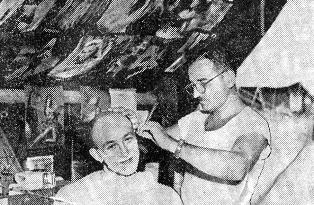
Stateside Institutions Follow |
Clip Joint In The Brambles
ADVANCE ASC BASE, BURMA - Wherever nostalgic G.I.'s go, Stateside institutions follow, almost before the sound and fury of battle is spent.
For good example, there is the "Burma Clipper," T/5 Archie DeLucca, who has proved himself as mobile as a field piece. DeLucca operates a two-man tonsorial tent, which he pitches whenever the Burma Peacocks, crack ASC group that keeps fighter craft flying in lead-spitting fury, settle down to work.
Inside the Burma Clipper's tent, that morale-lifter known as the pin-up is spread lavishly and alluringly on the canvas sides.
His equipment is strictly G.I., too, a set of barber instruments which he has carted with him since he sailed from Uncle Sugar. Shaving creams, lotions and powders with familiar trademarks from Uncle Sugar, supplied by the PX, are used to make veritable matinee idols out of jungle-wallahs.
Archie's conversational tune to the click of his scissors is usually about his year-old son, Gerald, who was born after he shipped for Burma.
Sundown over the Irrawaddy usually finds the Burma Clipper's shop a rendezvous for G.I.'s shooting the breeze and sweating out their turn in Archie's chair.
The C.B.I. Roundup is a weekly newspaper of the United States Forces, published by and for the men in China, Burma, and India, from news and pictures supplied by staff members, soldier correspondents, United Press, OWI, and Army News Service. The Roundup is published Thursday of each week and is printed by The Statesman in New Delhi and Calcutta, India. Editorial matter should be sent directly to Capt. Floyd Walter, Hq., U.S.F., I.B.T., New Delhi, India, and should arrive not later than Sunday in order to make that week's issue. Pictures must arrive by Saturday and must be negatives or enlargements. Stories should contain full name and organization of sender. Complaints about circulation should be sent directly to Lt. Boyd Sinclair, Hq., U.S.F., I.B.T., New Delhi, India. Units on the mailing list should make notification of any major change in personnel strength or any change of APO.

JANUARY 18, 1945
Original issue of C.B.I. Roundup shared by CBI veteran Robert L. Shaw
Copyright © 2006 Carl Warren Weidenburner
TOP OF PAGE PRINT THIS PAGE ABOUT THIS PAGE SEND COMMENTS
PREVIOUS ISSUE CLOSE THIS WINDOW NEXT ISSUE
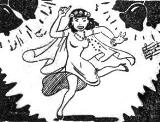
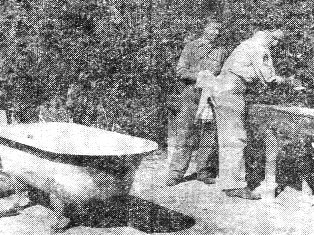 Outdoor bathing facilities of strictly Park Avenue standards have come to Assam, according to Pfc. Joseph Norgunis and
Sgt. Raymon G. Morgan, members of the Global Planesman ASC Group. The porcelain creation is in the Gent's Room of
Lost Horizon Lodge, a rest camp at the foot of the Himalayas. Ah, those suds.
Outdoor bathing facilities of strictly Park Avenue standards have come to Assam, according to Pfc. Joseph Norgunis and
Sgt. Raymon G. Morgan, members of the Global Planesman ASC Group. The porcelain creation is in the Gent's Room of
Lost Horizon Lodge, a rest camp at the foot of the Himalayas. Ah, those suds.